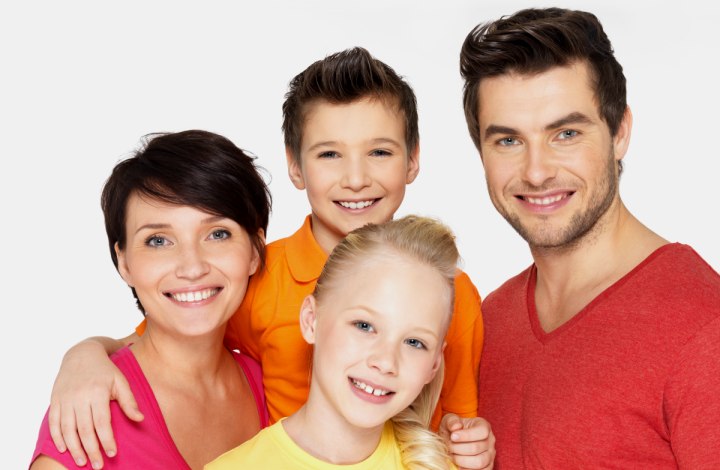Hair Color and Genetics

How Parents Affect the Color of their Babyís Hair
If you have ever taken the time to sit back and gaze at people at a park or other public setting, chances are you have seen a mom who is a brunette, a dad with black hair, and their two kids have red and blond hair respectively. How does this happen? You probably think to yourself, there is no way those are both the real parents.
Hair color is a multifaceted matter of genetic variations, with genes from both your mother and father determining the color and shade of their childís hair. Approximately 20 to 25 thousand genes determine our 46 chromosomes. Of these 46 chromosomes, 23 come from the mother and 23 from the father at the time of conception. One of the chromosomes will determine the sex and the other 45 chromosomes regulate all other aspects of the body, including how we look. As you can now imagine several combinations of genetic info can happen and create many different hair color possibilities for the child.
Science Facts
In the simplest terms, you can divide hair color into two different categories, light and dark. When it comes to dominance, dark hair takes over. This is why brown and the various shades of brown are the most popular hair colors worldwide. Fair shades, including blonde are much rarer. This could be one of the reasons that people spend hundreds of dollars every couple of months, trying to maintain fake blonde hair. Natural blonde hair is atypical when it comes to genetics and because of this is highly sought after. Eumelanin is the pigment that causes hair to be dark. If hair has a lot of eumelanin, it will be darker and if it has less of the pigment, it will be lighter.
How Parents Affect Hair Color
Parents' attribute to hair color comes from the quantity of eumelanin a baby has. Genes from each parent will contribute to the amount. There are thousands of DNA sequences which can be formed. Every gene is constructed of alleles or DNA sequences. Every trait that you carry comes from two alleles. One allele is from your mom, and one is from your dad. These can be the same traits or different. A brown/blonde gene is the most common in forming hair color. This consists of a brown allele from one parent and a blonde allele from the other. Someone that has a sequence of dominately brown alleles has a shade of brown hair and someone without any brown alleles in their sequence has blonde hair.
There are many other genes that control the shade of the color. The process in which a baby receives this allele is very random. This is the reason that you may not have exactly the same color of hair as any of your siblings. This also explains how two people with brown hair can have a child with light blonde hair. Both people have recessive blonde genes and these can be randomly thrown together to pass on to the child.
Red Heads
You may be thinking, how do people end up with red hair? The answer is that there are another set of genes known as the red/non-red pair that are present in humans. Red hair genes work in a slightly different manner.
The non-red allele is the dominant gene and will suppress production of pheomelanin, which is the pigment that gives hair a red color. A baby has to receive two red alleles to have red hair. Similar to blonde hair, where receiving two recessive alleles is less likely to happen, explains why red heads are less common than brunettes are. Orange and auburn shades are created by the first gene pair having a brown or blonde allele.
Environmental Factors
Hair color is mainly the result of the genes passed on to us by our parents. However, it is slightly more complicated than that. There are many genes that are muted allowing some individual traits to be shaped by the environment. Most often, this is personality, but weight and skin color can also be affected. We are born with some personality traits, but the way you are raised, your friends, and the school you attend can all shape your personality and what you become. This applies to an individualís weight and figure as well. If someone has friends who are thin, they may diet and exercise to become thinner, even if their body is not genetically programmed for thinness.
While the color of hair is determined in the womb, it is a fact that individuals in a certain group tend to have similar hair colors. One example of this is surfers who typically have light colored hair. The time in the sun and saltwater cause their hair to lighten. Dying hair is also popular and many groups of friends will color their hair the same because they like the color and they are able to. Chemicals and the sun play a large part in the color of our hair.
Darkening with Age
When it comes to hair color, most blonde babies and young children do not grow up to have blonde hair as adults. Similar to children born with blue eyes that later change to green or brown. Genes are similar to a light switch that can be turned on and off. Over time, a certain gene may turn off and change the color of our eyes or hair.
Genetics is a complicated science and not fully understood yet. Our parents are responsible for the color of our hair. However, there are so many random gene possibilities that it is hard to determine the color someoneís hair is going to be. It is actually quite rare for brothers and sisters to have the same exact hair color.
© Greatestlook.com
Photo: Valua Vitaly/Shutterstock
See also: Why hair turns gray